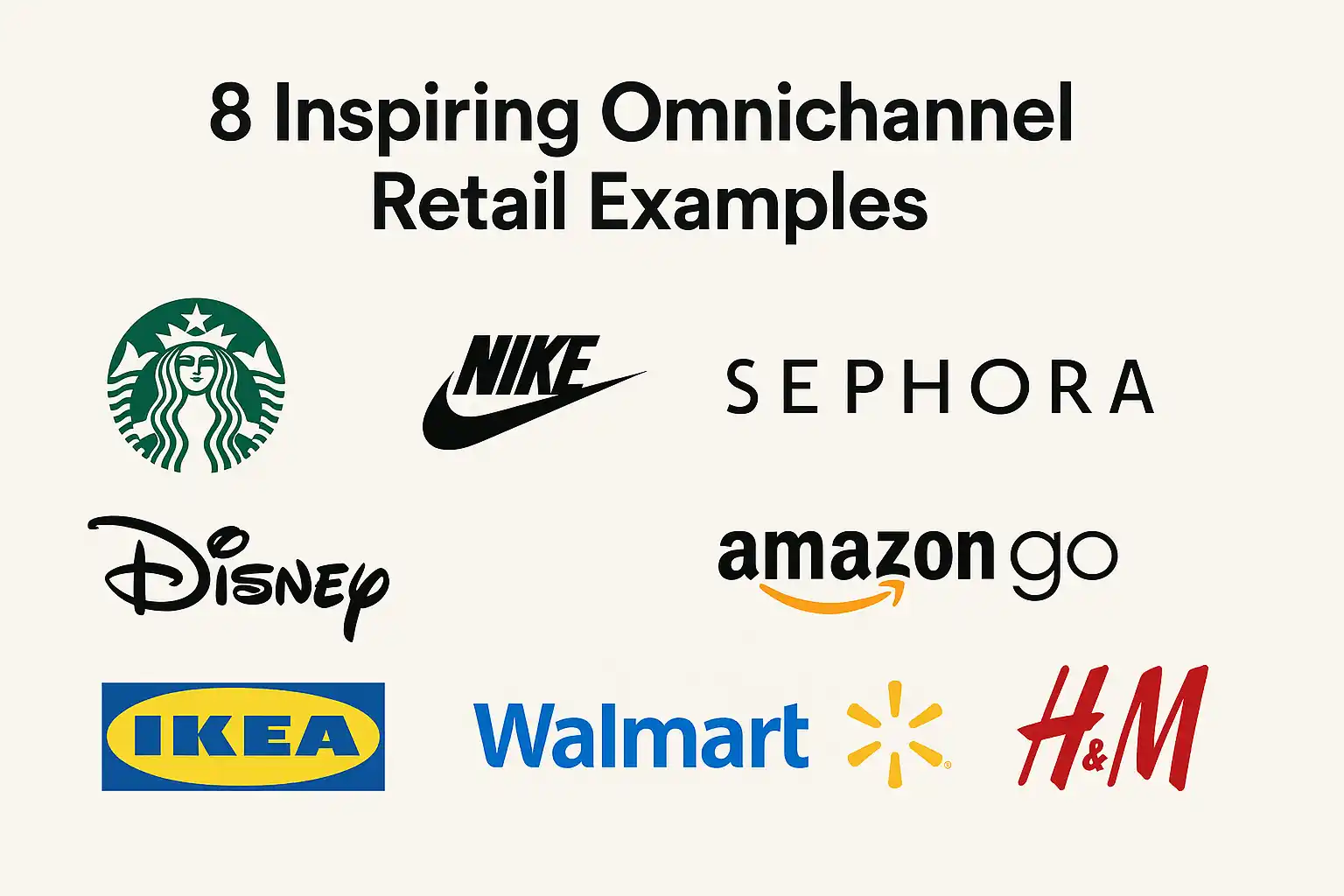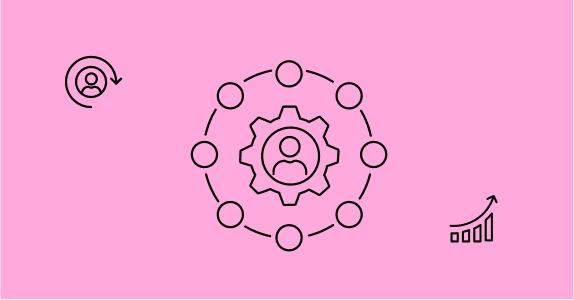TL;DR: Omnichannel Retail Examples 2025
- What it is: Omnichannel retailing connects online and offline touchpoints into one seamless customer journey.
- Benefits: Improved loyalty, deeper engagement, higher conversions, and unified customer insights.
- Best examples of omnichannel retail: Starbucks, Nike, Sephora, Amazon Go, Disney, IKEA, Walmart, and H&M.
- Key takeaways: Consistency, personalization, flexibility, and data integration are the foundations of omnichannel success.
- Trends for 2025: AI personalization, AR/VR retailing, voice commerce, and first-party data strategies.
- How to build your strategy: Understand customer journeys, integrate channels, personalize experiences, create cohesive flows, and optimize continuously.
Retail has transformed more in the past five years than it has in the past fifty. Consumers don’t think in “channels” anymore. They demand one continuous experience—whether they’re buying online, browsing in a store, swiping Instagram, or messaging customer service via WhatsApp.
That’s why examples of omnichannel retailing are so important. They reveal what happens when brands bridge the gap between online and offline, and stitch together fragmented interactions into frictionless experiences.
In this guide, I’ll dissect what omnichannel retailing is, why it’s important, and the top examples you can learn from to inform your own 2025 plan.
What Is Omnichannel Retailing?
Omnichannel retailing marries online and offline touchpoints together in one uniform customer experience.
Unlike multichannel (where every platform exists in silos), omnichannel makes data, offers, and customer experiences seamless.For example:
- Browsing online → Buying in-store with saved cart details
- Checking product availability on an app → Reserving it for pickup nearby
- Receiving personalized offers on WhatsApp → Redeeming them in-store
In essence, omnichannel isn’t about being everywhere—it’s about being connected everywhere.
Benefits of Creating an Omnichannel Retail Experience
Omnichannel retailing pays off in loyalty, engagement, conversions, and customer insights.
Key benefits include:
- Customer Loyalty → A consistent experience across channels builds trust and encourages repeat purchases.
- Higher Engagement → Meet customers where they are—timing messages across email, social, or WhatsApp.
- Increased Conversions → Behavioral nudges guide shoppers naturally toward purchase decisions.
- Deeper Insights → Unified data gives a holistic view of customer preferences for smarter campaigns.
The bottom line: better experiences = better business.
Omnichannel Retail Examples That Redefined Customer Journeys
The best omnichannel retail examples show how to move customers smoothly from awareness to loyalty.
These examples highlight strategies like:
- Unified loyalty programs (earning points online and in-store)
- Personalized retargeting (showing carted items across channels)
- Consistent brand storytelling across ads, emails, and retail displays
When done right, customers don’t notice the transitions between channels—they just feel a single, frictionless journey.
8 Best Examples of Omnichannel Retail in Action

Global brands have already cracked omnichannel, setting the benchmark for everyone else.
Here are 8 best examples of omnichannel retail worth studying:
- Starbucks – Rewards app links mobile ordering, loyalty points, and in-store pickup seamlessly.
- Nike – Mobile app ecosystem integrates product drops, training plans, and in-store events.
- Sephora – Beauty Insider program syncs wishlists, loyalty, and in-store product scanning.
- Amazon Go – “Just Walk Out” checkout blends app, sensors, and physical stores.
- Disney – Unified booking-to-park experience across app, site, and MagicBands.
- IKEA – AR-powered app lets customers “see” products in their home before buying.
- Walmart – Curbside pickup and app integration redefine convenience.
- H&M – Omnichannel returns allow customers to buy online, return offline.
Each shows a unique application of integration, personalization, and tech innovation.
Retail Omnichannel Examples and Ecommerce Success Stories
Ecommerce brands are proving that omnichannel doesn’t stop at physical stores—it extends across digital ecosystems.
Some retail omnichannel examples include:
- Apple: Apple’s omni channel strategy is built on the seamless integration of its online store, mobile app, and physical Apple Stores. Customers can begin their shopping journey online, reserve products, and complete their purchase in-store with personalised assistance.
- Caratlane: “Try at Home” option connects app browsing with physical consultation.
- IKEA: The brand ‘s omnichannel retail strategy creates a unified customer experience by seamlessly integrating its online (e-commerce website, app) and offline (physical stores, order pickup points) channels. Key features include the AR app for virtual product placement.
These show how retail + ecommerce integration can supercharge customer experience.
Key Takeaways from Leading Omnichannel Retailer Examples
In short: The best omnichannel retailers share common traits.
Key lessons:
- Consistency matters: Every channel reinforces the same brand promise.
- Data drives personalization: Unified data enables contextual, relevant offers.
- Flexibility wins: Customers can choose how and where they complete their purchase.
- Technology enables scale: CDPs, AI, and automation make true omnichannel possible.
If you take nothing else away: integration > presence.
Omnichannel Retail Trends for 2025
Omnichannel retailing in 2025 will be more AI-driven, immersive, and customer-led.
Emerging trends:
- AI personalization: Predictive recommendations in real time
- AR/VR retailing: Virtual try-ons and immersive shopping
- Voice commerce: Shopping via Alexa, Google Assistant
- Sustainability focus: Eco-friendly omnichannel campaigns
- Privacy-first personalization: Reliance on first-party data post-cookies
The future is about anticipating customer needs before they ask.
How to Build Your Omnichannel Retail Strategy
Building an omnichannel retail strategy isn’t about launching campaigns across every channel—it’s about making those channels work together. The goal is to create a frictionless, personalized journey that feels connected from awareness to loyalty.
Here’s a step-by-step approach:
1. Understand Your Customer Journey
Why it matters: You can’t design omnichannel experiences if you don’t know how your customers move between channels.
How to do it:
- Map customer journeys (awareness → consideration → purchase → loyalty).
- Collect behavioral data: where do they discover you (Instagram ads, SEO, word of mouth)? Where do they convert (app, store, website)?
- Use surveys, heatmaps, and analytics to identify friction points.
Example: A fashion retailer might find customers browse Instagram first, add items to their cart on mobile, but finish checkout on desktop.
Once you know this flow, you can connect the dots more intentionally.
2. Integrate Your Channels and Data
Why it matters: Disconnected systems = broken experiences. Integration ensures customers feel like they’re dealing with one brand, not multiple silos.
How to do it:
- Implement a Customer Data Platform (CDP) to unify purchase history, browsing data, and engagement across all touchpoints.
- Sync loyalty programs across channels—points earned online should be redeemable in-store.
- Ensure your inventory systems are connected, so customers see real-time stock availability.
Example: Nike’s app doesn’t just sell products; it syncs workouts, community events, and in-store drops—everything tied to one customer ID.
3. Personalize at Scale
Why it matters: Customers expect more than generic “Happy Diwali” emails—they want offers and nudges relevant to their behavior and context.
How to do it:
- Use AI-powered product recommendations (“complete the look,” “people like you also bought”).
- Send channel-optimized campaigns (WhatsApp for quick nudges, email for long-form content).
- Segment audiences beyond demographics—use affinity, purchase intent, and predicted cart value.
Example: Sephora’s omnichannel personalization ensures if you browse lipsticks online, you’ll get in-store recommendations for complementary products.
4. Create a Cohesive Journey
Why it matters: Customers don’t care about your org chart—they just want experiences that flow naturally.
How to do it:
- Design cross-channel campaigns with consistent creative and messaging.
- Ensure a cart started on mobile is visible on desktop and in-store.
- Orchestrate communications: teaser email → retargeting ad → WhatsApp reminder.
Example: Starbucks lets you order on the app, pay in-store, and still collect loyalty points—one seamless ecosystem.
5. Monitor, Measure, and Optimize
Why it matters: Omnichannel is not a one-time setup—it’s a continuous cycle of optimization.
How to do it:
- Track KPIs: retention, CLV, NPS, conversion lift from personalization, cart abandonment rates.
- Use A/B testing to refine touchpoints (timing of push notifications, placement of product recommendations, etc.).
- Continuously refine based on customer feedback and behavioral data.
Example: Amazon constantly optimizes its omnichannel approach by analyzing how Prime customers interact across Alexa, app, and physical stores.
The Core Principle
An effective omnichannel retail strategy isn’t about doing everything everywhere. It’s about:
- Knowing your customer,
- Connecting your channels,
- Personalizing intelligently, and
- Optimizing continuously.
Do this well, and customers won’t think about channels at all—they’ll just experience your brand as one smooth, cohesive journey.
Final Take: Omnichannel Retail
Omnichannel retail isn’t just about keeping up with trends—it’s about driving measurable growth and ROI. Leading brands prove that integrating online and offline touchpoints can:
- Increase conversions by 20–30% through seamless, personalized journeys.
- Boost customer lifetime value (LTV) by building loyalty and retention.
- Lower acquisition costs by engaging customers effectively across multiple channels.
The best part? Building an omnichannel marketing approach is easier than ever with the right tools and support. Platforms like Netcore simplify integration, personalization, and campaign orchestration—so you can scale without overwhelming your team.
But here’s the catch: every day you delay implementing omnichannel is a day you lose customers to competitors who already deliver these experiences.
Ready to see how omnichannel can transform your ecommerce growth? Book your personalized demo now and gain:
- A tailored strategy for your brand’s customer journey
- Insights into boosting conversions, retention, and revenue
- Hands-on guidance from experts who’ve powered success for Flipkart, HDFC, Tommy Hilfiger, and more
Don’t just admire omnichannel retail examples—become one.
 Holiday Sales Are Won Now — Grab the 2025 Holiday Marketing Guide to Unlock More Revenue.
Holiday Sales Are Won Now — Grab the 2025 Holiday Marketing Guide to Unlock More Revenue. 













